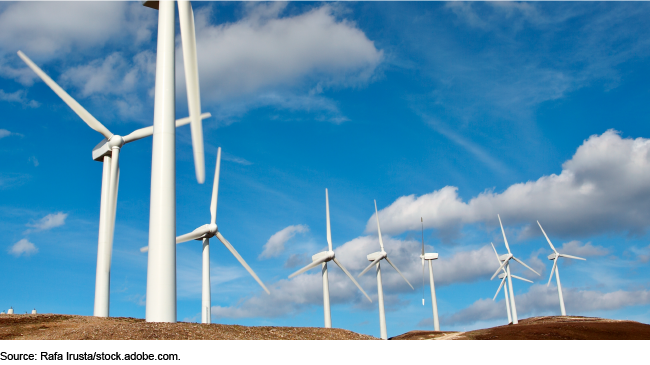Wind Energy: Technologies and Approaches to Help Address Environmental Effects
Fast Facts
Wind energy is one of the fastest-growing renewable energy sources globally.
Getting electricity from wind can have significant environmental and public health benefits. But the development of wind energy facilities could also change the landscape, affect wildlife, and have other negative environmental effects.
In this Technology Assessment, we identified technologies and approaches to help address these effects across a wind facility's life cycle. But challenges such as costs may limit their use. For example, recycling turbine blades is currently more expensive than disposing of them in landfills.
Our 5 policy options address these challenges.

Highlights
What GAO Found
Total annual U.S. electricity generation from onshore and offshore wind energy increased from about 6 billion kilowatt-hours (kWh) in 2000 to about 430 billion kWh in 2023, an increase of over 7,000 percent and resulting in wind energy generation providing about 10.2 percent of the electricity in the United States in 2023. Because a continued scale-up in deployment of wind energy facilities could increase the potential environmental effects of these facilities, GAO identified technologies and approaches to address potential effects of wind energy to the physical environment, animals, or humans across a facility’s life cycle. These technologies and approaches can be used individually or in combination to address environmental effects. For example, visual monitoring technologies can be placed on uncrewed vehicles to gather data on animal presence and abundance in challenging environments.
Select technologies or approaches in use or under development to help support data collection to address environmental effects

However, challenges may limit the use of technologies and approaches to address environmental effects. Some technologies and approaches may incur additional direct costs for a wind energy developer, potentially creating a barrier for use by making the facility's electricity less cost-competitive in the electricity marketplace. Technologies and approaches have to maintain quality assurance during the operation and lifetime of a turbine. Meanwhile, knowledge gaps about projects can make it difficult to determine how to most effectively use technologies and approaches to address challenging effects. Further, some technologies and approaches such as machine learning and modeling require large amounts of data and energy, and barriers to data access may limit the effectiveness of a technology or an approach.
GAO identified five policy options that could help address these challenges or enhance the benefits to technologies and approaches for addressing potential environmental effects of wind energy. These policy options identify possible actions by policymakers, which include Congress, federal agencies, state and local governments, academia, research institutions, and industry. See below for a summary of the policy options and relevant opportunities and considerations.
Policy Options to Help Enhance Benefits or Address Challenges
| Policy Option | Opportunities | Considerations |
|---|---|---|
| Status quo (report p. 25). Policymakers could take no further intervention, allowing current activities to continue. |
|
|
| Encourage innovation and research (report p. 25). Policymakers, such as Congress, academic institutions, industry organizations, or others, could encourage research and development of technologies and approaches to address potential environmental effects. |
|
|
| Data sharing (report p. 26). Academic institutions or other policymakers could facilitate improved data sharing about potential environmental effects, technologies, and approaches. |
|
|
| Establish consistent methodologies (report p. 27). Policymakers such as academic institutions or industry could encourage the use of consistent methodologies to study wind energy facility sites and to address data and research limitations. |
|
|
| Incentives (report p. 28). Policymakers such as government entities could consider incentivizing the use of technologies and approaches to address environmental effects. |
|
|
Source: GAO. | GAO-24-106687
Why GAO Did This Study
Wind energy is one of the fastest-growing renewable energy sources globally. Onshore and offshore wind energy provide an abundant source of electricity with significant environmental benefits, including lower atmospheric greenhouse gas emissions during electricity generation. However, the increases in the development of wind energy facilities increases the potential environmental effects of these facilities, including greater use of natural resources like critical materials and steel, decommissioning and recycling difficulties, and ecological effects such as wildlife harm.
This report discusses (1) technologies or approaches to help reduce the potential environmental effects related to the life cycle of utility-scale wind energy projects, (2) challenges that might hinder implementation of these technologies or approaches, and (3) policy options to help address these challenges.
To conduct this technology assessment, GAO reviewed evidence, including articles and other reports; interviewed government, industry, and academic stakeholders; conducted a site visit; and convened an expert meeting with the assistance of the National Academies of Sciences, Engineering, and Medicine. GAO is identifying policy options in this report.
For more information, contact Karen L. Howard, PhD, at (202) 512-6888 or HowardK@gao.gov.
